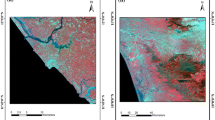Abstract
Water spread area is one of the few parameters that can be easily derived using multispectral satellite data. However, due to limitation in land–water boundary pixel delineation and availability of area estimate from simultaneous images of different spatial resolutions, it poses serious challenges for accurate estimation of water spread area. The area estimated from data of different resolutions is not the same owing to many factors like shape and size of the water body and the efficiency of the approaches to delineate land–water boundary pixel. In addition to this, multiple coverage of same water body from sensors of different resolutions will lead to varying water spread area estimates. In order to assess the effect of these factors on water spread area estimate, a study was undertaken to assess the accuracy of water spread area estimate using the field-based measurement and to establish relationship for normalisation of water spread area estimate from different resolution sensors. In this study, water boundary was traced by collecting continuous measurements of location with the help of satellite-based positioning system. The study showed that water spread area estimated through linear spectral unmixing of images from LISS IV, LISS III, AWiFS and MSI sensors resulted in better estimate compared to the index-based method. The error in estimate was less than 5% in all the cases except for AWiFS-based estimate for the smaller water body. The study also concluded that either simple linear regression equation or multiple linear regression equation can be used to normalise the water spread area estimated from different sensors.








Similar content being viewed by others
References
Carmen, Q., Alfonso, F.-M., Shimabukuro, Y. E., & Pereira, G. (2012). Spectral unmixing. International Journal of Remote Sensing, 33(17), 5307–5340. https://doi.org/10.1080/01431161.2012.661095.
Cui, Q., Shi, J., & Xu, Y. (2011). Estimation of sub-pixel water area on Tibet Plateau using multiple endmembers spectral mixture spectral analysis from MODIS data. Proceedings of SPIE—The International Society for Optical Engineering. 8006. 64-. https://doi.org/10.1117/12.901987.
Ganeshan, A. S., Satih, S. V., Karthik, A., Nirmala, S., & Ramesh, G. (2016). India’s satellite-based augmentation system, GAGAN—redefining navigation over the Indian region. Inside GNSS, 42–48. https://insidegnss-com.exactdn.com/wp-content/uploads/2018/01/janfeb16-GAGAN.pdf. Accessed 28 August 2020.
Huang, C., Chen, Y., Zhang, S., & Wu, J. (2018). Detecting, extracting, and monitoring surface water from space using optical sensors: A review. Reviews of Geophysics, 56, 333–360. https://doi.org/10.1029/2018RG000598.
Keshava, N. (2003). A survey of spectral unmixing algorithms. Lincoln Laboratory Journal, 14, 55–78.
Kopackova-Strnadova, V., & Hladíková, L. (2014). Applying spectral unmixing to determine surface water parameters in a mining environment. Remote Sensing, 6, 11204–11224. https://doi.org/10.3390/rs61111204.
Manisha Shah, B., & Shilp, V. (2017). Reviving minor irrigation in Telangana—midterm assessment of mission Kakatiya, Water Policy Research Highlight-08.
McFeeters, S. K. (1996). The use of the Normalized Difference Water Index (NDWI) in the delineation of open water features. International Journal of Remote Sensing, 17(7), 1425–1432. https://doi.org/10.1080/01431169608948714.
NRSC. (2020). Water Body Information System (WBIS). Available at: https://bhuvan-wbis.nrsc.gov.in/. Accessed 26 August 2020.
Shanmuga Priyaa, S., Jeyakanthan, V. S., Heltin Genitha, C., & Sanjeevi, S. (2018). Estimation of water-spread area of Singoor Reservoir, Southern India by super resolution mapping of multispectral satellite images. Journal of the Indian Society of Remote Sensing, 46, 121–130. https://doi.org/10.1007/s12524-017-0666-x.
Subramaniam, S., Suresh Babu, A. V., & Roy, P. S. (2011). Automated water spread mapping using ResourceSat-1 AWiFS data for water bodies information system. IEEE Journal of Selected Topics in Applied Earth Observations and Remote Sensing, 4(1), 205–215. https://doi.org/10.1109/JSTARS.2010.2085032.
Suryanarayana Rao, K. N. (2007). GAGAN -The Indian satellite based augmentation system. Indian Journal of Radio & Space Physics, 36(4), 293–302.
Xu, H. (2006). Modification of Normalized Difference Water Index (NDWI) to enhance open water features in remotely sensed imagery. International Journal of Remote Sensing, 27, 3025–3033. https://doi.org/10.1080/01431160600589179.
Yang, X., Zhao, S., Qin, X., Zhao, N., & Liang, L. (2017). Mapping of urban surface water bodies from Sentinel-2 MSI imagery at 10 m resolution via NDWI-based image sharpening. Remote Sensing, 9, 596.
Yuan, C., Wang, F., Wang, S., & Zhou, Y. (2019). Accuracy evaluation of flood monitoring based on multiscale remote sensing for different landscapes. Geomatics, Natural Hazards and Risk, 10(1), 1389–1411. https://doi.org/10.1080/19475705.2019.1580224.
Acknowledgements
The authors would like to thank senior officials of National Remote Sensing Centre (NRSC) for their encouragement and technical guidance during the study. The authors would like to specifically thank Dr PVN Rao, Deputy Director, RSA, NRSC, for triggering this study to assess the accuracy of water spread estimate from remote sensing through field-based survey. The authors are grateful to the anonymous reviewers for their careful reading of our manuscript and their many insightful comments and suggestions that brought significant improvements in the manuscript.
Author information
Authors and Affiliations
Corresponding author
Additional information
Publisher's Note
Springer Nature remains neutral with regard to jurisdictional claims in published maps and institutional affiliations.
About this article
Cite this article
Kompella, S., Kadapala, B., Abdul Hakeem, K. et al. Accuracy Assessment and Normalisation of Water Spread Area Estimate from Multi-sensor Satellite Data. J Indian Soc Remote Sens 48, 1601–1611 (2020). https://doi.org/10.1007/s12524-020-01185-6
Received:
Accepted:
Published:
Issue Date:
DOI: https://doi.org/10.1007/s12524-020-01185-6




